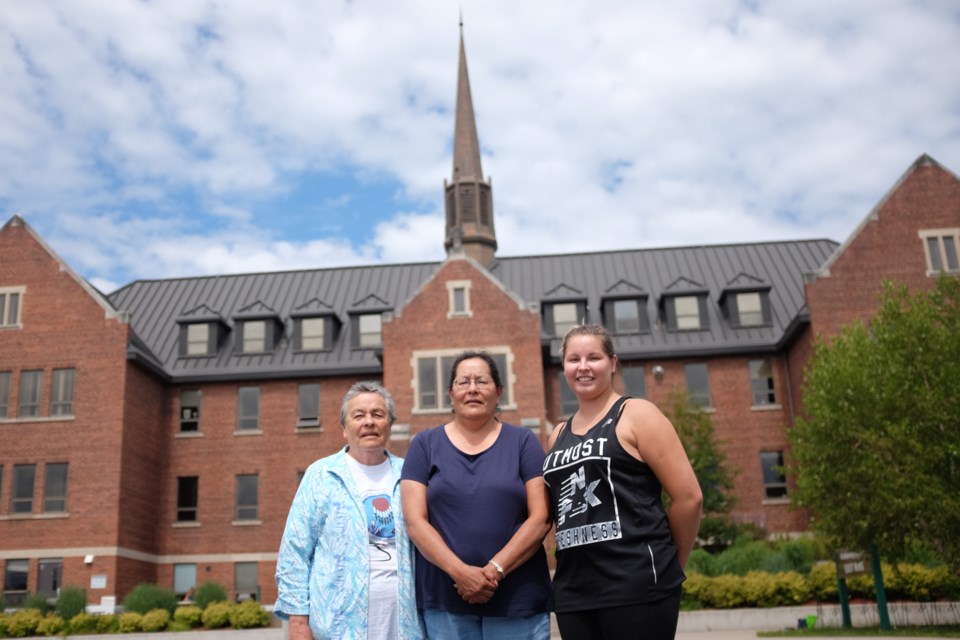Residential Schools were government-sponsored and religious-affiliated boarding schools for First Nations’ people that lasted from the late 1800s until the 1990s.
These schools left behind a legacy of physical, verbal, and sexual abuse, death, and cultural genocide.
Children were often kidnapped from their communities and forced to attend these schools, where they were then not allowed to speak their language or learn about and practice their culture.
Sault Ste. Marie’s Shingwauk Residential School closed in 1970 and the building is now part of Algoma University.
At Algoma University over the weekend, The Children of Shingwauk Alumni Association (CSAA) held the Shingwauk Gathering and Conference.
The gathering brought former residential school students from across Canada together.
These former students spoke about their experiences as ‘survivors’, and they discussed the incredible hardships they endured.
Their descendants are considered ‘intergenerational survivors’, those who were effected by the residential school system by patterns that were passed down through the generations.
Some of these people told their stories.
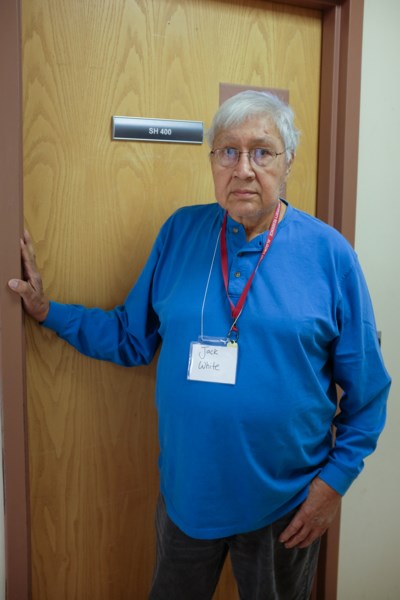 Jack White attended Shingwauk Residential School from 1941 until 1953. White is standing by the door to former dormitory, which is now a classroom at Algoma University. White did not have a pleasant time remembering his Shingwauk childhood. Photo by Jeff Klassen for SooToday
Jack White attended Shingwauk Residential School from 1941 until 1953. White is standing by the door to former dormitory, which is now a classroom at Algoma University. White did not have a pleasant time remembering his Shingwauk childhood. Photo by Jeff Klassen for SooTodayJack White
Jack White went to Shingwauk Residential School in 1941 and stayed for 12 years.
Sitting in the old Shingwauk school on the weekend, White was uncomfortable and sometimes his passion turned into loud anger as he spoke.
“The first day (of residential school) was a beautiful memory. I started to say something to the lady and she slapped me. I tried to say something again and she slapped me again. I said something again and she slapped me again. Three times she slapped me, then I shut up. The other guy told me later, in Indian, that we can’t speak our tongue at the school. We had to speak English and I didn’t even know English. That was the start of my hatred of this place,” said White.
“(For food) we got mush, two slices of bread, and a three quarter cup of what they called cocoa in the morning for 365 days a year. (The staff) are sitting in their room having bacon and eggs, coffee and tea, crumpets, whatever, and we’re starving. There were no fat kids at Shingwauk.”
White said that he would get called a “savage” and other names and that it was common to get hit or slapped.
“So you learn to not talk to them anymore and you ignore them. They get upset with that too but it's still a lot easier. You don’t make bonds with them. You just do what you’re told and that’s it,” he said.
White said that people and experiences will often trigger “flashbacks” of his time at Shingwauk and that, when he was younger and didn’t learn to control it, that would lead to him getting violent.
“Somebody will say something and a reaction comes out and then hatred, it's just like a rage. I’ve learned to control it.”
He also spoke of long-term and intergenerational effects.
“What was taught (at Shingwauk) really affected your home life. I could never hug my children. I could never tell them I love them. I had girlfriends; I didn’t know how to treat them. I ended up beating them up. Why? I was taught to do that at Shingwauk. The staff beats you up, that’s what you do. So you’re home life is disarrayed right off the bat. It’s pretty sad. (Once) my oldest son said, ‘yeah, Shingwauk really did a number on me.” It still haunts me to today. My son was just a kid, he did something wrong and I spanked him. Then Children’s Aid got in there and all this stuff I was taught by the white people (however) they blame me for beating him up. I said what do you want me to do? You did the same thing to me.“
“I think this will be my last Shingwauk Gathering,” said White, expressing emotional exhaustion from years of dealing with these issues.
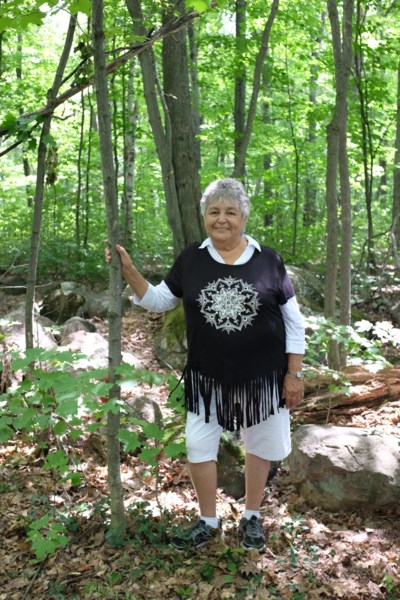 Jackie Fletcher attended Shingwauk Residential School from 1959 until 1963. Photo by Jeff Klassen for SooToday
Jackie Fletcher attended Shingwauk Residential School from 1959 until 1963. Photo by Jeff Klassen for SooTodayJackie Fletcher
Jackie Fletcher was 14 when she attended Shingwauk Residential School in 1959.
She remembers entering up the steps and through the main doors with her nine-year-old sister.
“My younger sister had never been away from my parents before. She just screeched and hollered. That’s the most painful memory I have, that I couldn’t do anything to help her,” said Fletcher.
Fletcher said she was treated like a rock star by the other girls at Shingwauk because she showed up as a confident teenager with a guitar.
Her sister however, did not do well.
“When we went to meals I couldn’t cross the line to go and hug her. Every time she saw me she’d cry and call my name and I couldn’t do anything about it. That was so painful and hurtful. She almost died in that school after just one year. She got so sick and she wouldn’t eat. She had impetigo sores all over her mouth, I know why today. It was a physical manifestation of a psychological issue. She couldn’t speak for herself, that’s why those sores showed up.”
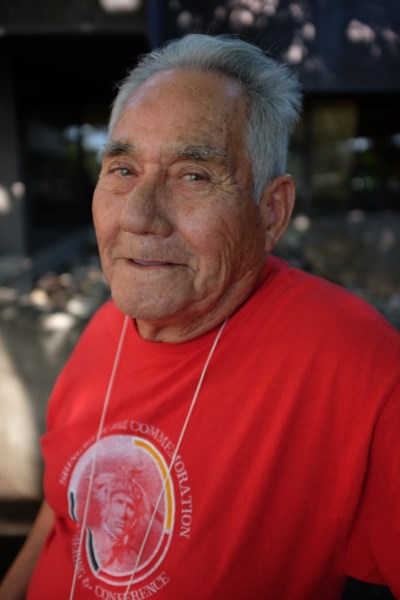 John R. Elliot started attending Mohawk Institute Residential School in Brantford, Ontario in 1947. Photo by Jeff Klassen for SooToday
John R. Elliot started attending Mohawk Institute Residential School in Brantford, Ontario in 1947. Photo by Jeff Klassen for SooTodayJohn R. Elliot
John R. Elliot went to the Mohawk Institute Residential School of Brantford when he was 10 years old.
He said it was nicknamed ‘The Mush Hole’, a testament to the poor quality food they were served and a particular reference to ‘mush’, a bland porridge frequently served and despised by students at residential schools across the country.
Elliot grew up on Six Nations Reserve where, even as a very young child, him and his brothers and sisters would often skip school to make money trapping raccoons, skunks, and muskrats.
Back then they’d get $3 for a nice black skunk pelt.
Elliot didn’t really like going to public school that much and would often act up.
“Sometimes we’d throw the part of the skunk that stunk on the big pot belly stove as a prank and they’d have to close down the school.”
After behavior like this and missing too many days of public school, him and his brother and sister were sent to the residential school.
On their first day there, before even spending one night, him and his brother ran away.
His grandfather took them back the next day but it was not the last time they'd do something like that.
Elliot said the school was a rough place.
“When you went there (the other students) put you in a ring and you fought until someone beat you and then you knew where you stood in the group,” he said.
Elliot was a playful youth with lots of energy and who enjoyed being outside
His rambunctious demeanour didn’t go over well with a farm boss at the school.
He was caught riding calves on the school’s farm one day and as punishment he got hit so hard he lost 90 per cent of the hearing in his left ear.
Elliot said that he would run away from the school four or five times a year, usually for a few nights at a time.
During these escape runs, him and his brother would make cardboard shelters, go fishing, and even hunt or trap animals.
Running away and being in the woods with his brother is some of his fondest childhood memories.
Every Christmas he’d run away so that he could spend time at home with his family.
“It was good times but when you got back you had to pay,” said Elliot describing a strap, inches wide, that they would spank his bare skin with.
But, talking to Elliot, his spirit is so bright and he doesn’t seem to hold any negative emotions.
“They didn’t break me that’s for sure,” he said with a big smile.
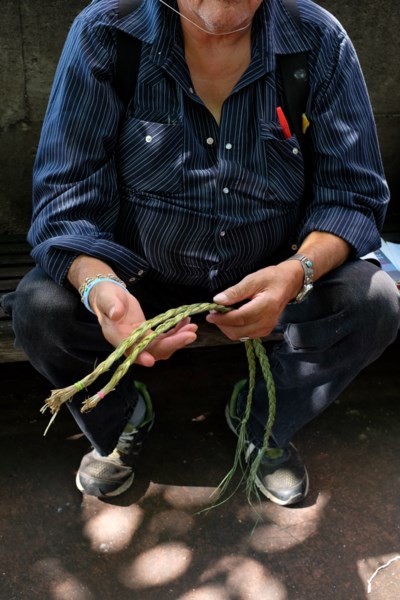 ‘Mike’, real name withheld, started attending a residential school in Spanish, Ontario in 1952. Mike found healing through learning about his First Nations’ culture. At he Shingwauk Gathering on Saturday he was braiding sweet grass for people. Photo by Jeff Klassen for SooToday
‘Mike’, real name withheld, started attending a residential school in Spanish, Ontario in 1952. Mike found healing through learning about his First Nations’ culture. At he Shingwauk Gathering on Saturday he was braiding sweet grass for people. Photo by Jeff Klassen for SooToday‘Mike’
In 1952, at seven years old, ‘Mike’s’ (real name withheld) mother contracted tuberculosis and a priest recommend that his father, who had a difficult time raising children alone, place him and his brother into a residential school in Spanish, ON.
He spent two and a half years at the school, many of the memories still difficult for him to talk about today.
Mike said that the winter was particularly difficult at the school as even when it was -30 degrees Celsius the children were still required to go out side and play.
“One time they had to drag one kid home by a toboggan because he was nearly frozen,” he said.
Because he had already been to other schools, the simple education at the Spanish residential school did not stimulate him in any way.
“I would sit in school and just look out the window in wonder. Through the window there was a place that looked like where I was from, this red tar paper house. As I looked at it I would visualize I was home. I would just sit and stare at it for months and months and months,” he said.
During those years Mike was overwhelmed by the stress and developed a chronic habit of frequent sexual self-gratification.
“I dealt with my pain through my own personal way and I found my own gratification to get away. It was a way of relieving the pain,” he said.
After years of living with this form of escape, Mike added alcohol to his vices.
Much of his adult years were spent drunk and in “a lot of pain, jails, and hospitals”.
34 years ago he got involved with Alcoholics Anonymous and these days he is a peer mentor to First Nations’ people with alcohol problems.
He also overcame his sexual escapism, started developing relationships, and for the first time in his life started becoming connected to his cultural roots, something he feels he was denied at the residential school.
At the Shingwauk Gathering over the weekend, Mike was braiding ropes of sweet grass for people.
“When you braid the hair of mother earth, it represents the strength we have as First Nations’ people. It’s unbreakable,” he said.
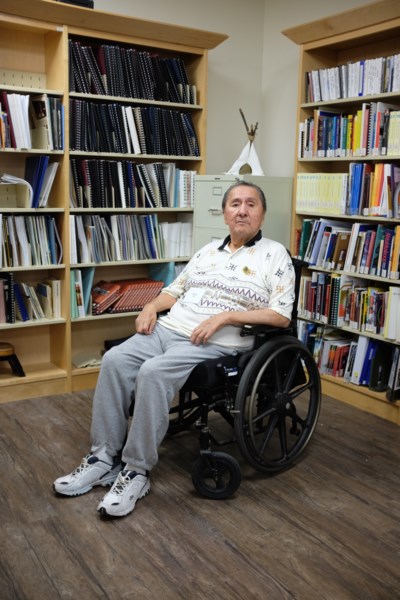 Richard Owl went to Shingwauk Residential School in the 1930s and 1940s. Photo by Jeff Klassen for SooToday
Richard Owl went to Shingwauk Residential School in the 1930s and 1940s. Photo by Jeff Klassen for SooTodayRichard Owl
Richard Owl went to Shingwauk in the 1940s and 1950s, from the ages of 7-10.
His mother brought him there because there was no school on his reserve.
“You couldn’t say anything in Indian or they'd wash your mouth out with soap. I couldn’t speak English or understand it, just Indian, that’s all I knew. The people just started talking to me in it and I just didn’t know what was going on,” he said.
Owl went home in the summer and told his parents how difficult the school was but they didn’t believe him.
He did not get into the details of his experience.
“Lots happened, all I can say is lots.”
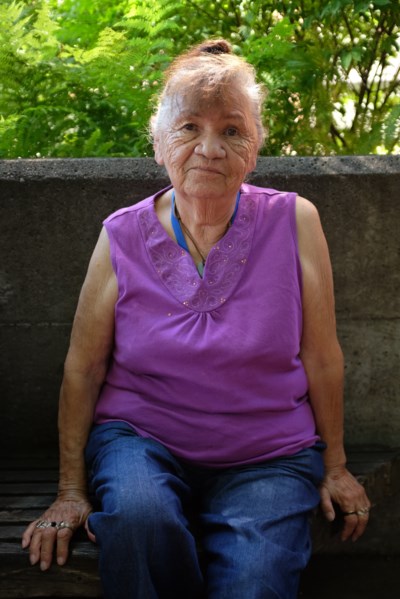 Una Day started attending Shingwauk Residential School in 1940. Photo by Jeff Klassen for SooToday
Una Day started attending Shingwauk Residential School in 1940. Photo by Jeff Klassen for SooTodayUna Day
Una Day went to Shingwauk in 1940 when she was four-years-old.
She said a ‘white Indian agent’ came to her community on Walpole Island and picked children from different homes.
She was chosen because she was living with her grandmother after her single mother left to find work in Detroit.
When she arrived at Shingwauk she was the second youngest in the whole school.
“They carried me (into Shingwauk) like a baby. They put me down on the floor and my sister was already here. When she saw me, she just started to cry,” she said.
Day wasn’t sure if her sister cried with tears of joy or tears of happiness.
But, for Day, Shingwauk was not a negative experience.
Back at home she was lonely because there was no one to play with and so she liked being around all the children.
Day stayed at Shinwauk for 10 years and she describes it as a “normal experience”.
“I was okay, overall. I was alone with my grandparents so I liked all the kids to play with (at Shingwauk). I came through it okay. They fed us. I never had any bad experiences,” she said.
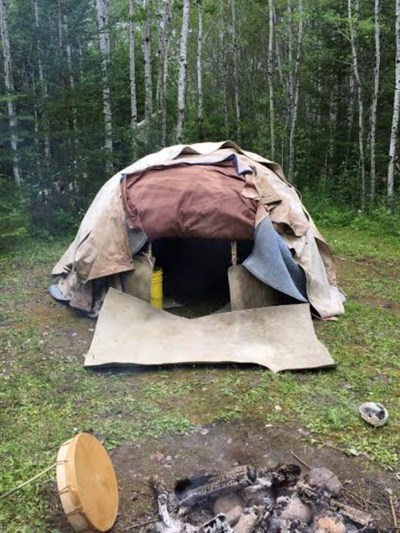 ‘Simon’ (real name withheld) attended St. Anne’s Residential School in Fort Albany in 1963 and later went to St. Joseph’s Residential School in Thunder Bay. Simon helps others who went through the residential school system. One healing tool he uses personally and with others is a sweat lodge. Photo Submitted
‘Simon’ (real name withheld) attended St. Anne’s Residential School in Fort Albany in 1963 and later went to St. Joseph’s Residential School in Thunder Bay. Simon helps others who went through the residential school system. One healing tool he uses personally and with others is a sweat lodge. Photo Submitted‘Simon’
‘Simon’ (real name withheld) attended St. Anne’s Residential School in Fort Albany in 1963 and later went to St. Joseph’s Residential School in Thunder Bay.
He has no positive memories.
“They picked us up from our reservation. They just came and took the five youngest without asking. They put us on plane. I was terrified. I’ve never been on a plane in my life. To this day I don’t fly. If they have gatherings anywhere, even if it’s a thousand miles away, I’ll drive," he said.
Simon said he suffered physical, verbal, and sexual abuse at residential schools, the effects of which last to this day.
“Like everyone else I went through the streets. Lots of drinking sent to jail, drunk all the time. I was abusive to my partner; trouble in courts.”
At 27 Simon decided to clean up his life and he went to school to become a drug and alcohol counselor.
“Every time they sent me a client that had sexual abuse issues, I started having anxiety attacks. I started sweating and shaking and I’d tell the client that I couldn’t help them, that I couldn’t listen to what they were saying. I went to see a psychologist and he asked me, ‘you’re a victim of sexual abuse aren’t you?’ I said yes and he said ‘you can’t talk to other people because you can’t deal with your own stuff.’
These days Simon is a Residential School Health Support Worker.
He often travels to events like the Shingwauk Gathering and helps people work through incredibly difficult issues as they arise.
“Today I help people, residential school people, drug and alcohol people, people in jails, etc. Most of my life I dedicate to people who are going through hard times in their life. Sometimes I want to quit because there is just so much. This job, it gets to me once and a while, there are so many triggers. Everyone is telling their story, I’ve heard it before, it’s my story. Even though I did a lot of work to fix myself up, it still hurts.”
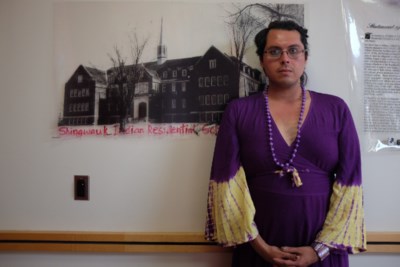 Teddy Syrette is an intergenerational residential school survivor. Syrette’s grandmother spent ten years at St. Joseph’s Residential School for girls in Spanish, ON. Photo by Jeff Klassen for SooToday
Teddy Syrette is an intergenerational residential school survivor. Syrette’s grandmother spent ten years at St. Joseph’s Residential School for girls in Spanish, ON. Photo by Jeff Klassen for SooTodayTeddy Syrette (Syrette prefers the gender-neutral term ‘they/their’)
Teddy Syrette didn’t know their grandmother attended a residential school until one month after she died.
“I came across some ruins (in the town of Spanish, ON) and took a picture. It was something I had a really good resonance with. I later showed it to my dad and he said ‘that’s the school your grandmother went to.’
Syrette’s grandmother spent ten years at St. Joseph’s Residential School for girls in Spanish, ON.
Syrette said that, based on information gathered since, their grandmother rarely mentioned her time at the school and when she did she would only say positive things even though one of her siblings passed away in the school, they think from an illness.
“My grandmother never had a problem with the residential school she went to. The school taught her how to sew and she used that as a way to finance herself and her family later on in life, even telling her own children that she would send them to a residential school if they were still in effect… This was very frustrating and scary for my father and my aunt because they knew about the other stories of what took place in these schools so they were just really dumbfounded by it,” said Syrette.
Syrette is an intergenerational survivor.
“Whether it’s indirectly by being raised by somebody or as a great grandchild, (intergenerational survivors) might hold, what we know in our culture as, blood trauma. The blood from our ancestors has trickled down through the bloodlines and it can hold a certain amount of stress (and) traumatic events that occurred can be passed on through the bloodlines. There’s a lot of aspects of violence and substance abuse that trickled on after the first generation that went to a residential school. I myself faced issues of alcoholism and depression, for multiple reasons, but a lot of them could have stemmed from that,” said Syrette.
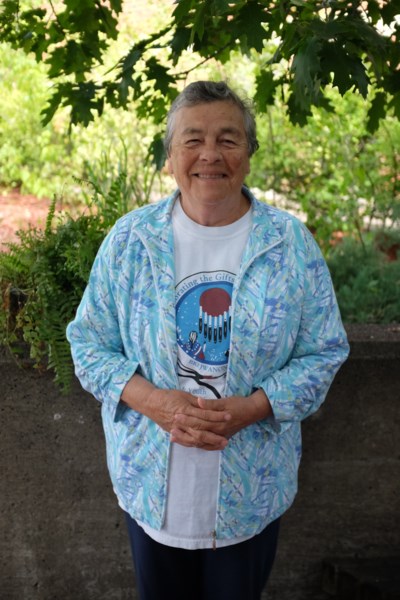 Susie Jones went to Shingwauk Residential School from 1941 until 1953. Photo by Jeff Klassen for SooToday
Susie Jones went to Shingwauk Residential School from 1941 until 1953. Photo by Jeff Klassen for SooTodaySusie Jones
Susie Jones went to Shingwauk from 1941 until 1953.
When she was four years old her and her six year old brother were taken from their front yard by an Indian agent.
“My brother and I were standing by the front part of our property and a car came and just put us in and off we went. They just took children like that. They grabbed children from anywhere they could. They kidnapped you.”
Jones discussed what she considers to be cultural genocide.
“What they do to your mind is negative. They change you, they make you something that you’re not. They make you speak a language that’s not your own and it doesn’t make sense to you. It was demeaning, it made you less of a person,” she said.
Jones was taken at a young age and she was able to learn English very quickly but she never got a chance to learn about her culture.
“I was taught how to be an Irishman and a Scotsman. I have a picture of myself in an Irish costume (from her time at Shingwauk). I had to learn their songs, their way of dress, some of their history. Why they picked Scotch and Irish I don’t know because (in Sault Ste. Marie) there were lots of Italians and Finnish. They never promoted or taught us anything about our culture. They would whip you if you talked about it, talked about home, or talked about your family. My brother that died here had to write home and tell them how much he liked it here. (If he said negative things in his letters) they’d tear it up.”
Jones said she hasn’t really ever been able to fully get her culture back, she knows the basics, but not everything.
“I’ve noticed a lot of people rely on culture now to do their healing, so I know it’s important,” she said.
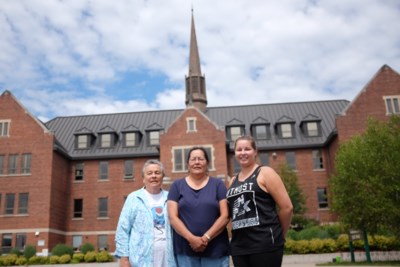 (From left) Susie Jones, her daughter Joy Susan Carr, and Jones’ granddaughter Taylor Jones. Susie Jones attended Shingwauk Residential School from 1941 until 1953. Taylor Jones’ great great grandfather, her great grandfather, and her grandfather and grandmother attended residential schools. Photo by Jeff Klassen for SooToday
(From left) Susie Jones, her daughter Joy Susan Carr, and Jones’ granddaughter Taylor Jones. Susie Jones attended Shingwauk Residential School from 1941 until 1953. Taylor Jones’ great great grandfather, her great grandfather, and her grandfather and grandmother attended residential schools. Photo by Jeff Klassen for SooTodayJoy Susan Carr
Joy Susan Carr is an intergenerational residential school survivor.
Carr’s most distant relative to attend a residential school was her great grandfather while her most recent was her parents, who both went to Shingwauk.
Susie Jones is her mother.
She talked about the effects residential schools had on her family and why, years later, even her grandchildren are also considered ‘survivors’.
“Myself, my kids, and my grand kids didn’t attend the schools but we have the impacts of them through our relatives that attended. The impacts are lasting through the generations. I was well into my forties before my parents hugged me,” said Carr.
“The most important thing that I feel that has been passed on (through the generations) is that the survivors in those schools didn’t have a parent model. If you don’t have a parent model what are you going to do when you become a parent?” she said.
Carr said people were affected by the residential schools in different ways.
A prime example, she said, is her parents, one who seemed to make something positive from their experience, the other who seemed to be emotionally damaged by it.
“My mom always wanted to do good and always wanted to be right and when she became a parent she made sure we had a clothes, food, and a warm house. In a lot of native communities those aren’t the priorities. How she happened to get that good part of her was because she wanted to be good in school. She didn’t get in trouble, she didn’t get physically abused all the time. There were physical issues (like not having enough clothes or food, being away from the family, and not having a culture) but she turned out the opposite of my father. My dad was a very strict disciplinarian. So we had two different parenting styles.”
Carr said that after hearing the stories of residential schools survivors at events like the Shingwauk Gathering and Conference, she’s been able to relate patterns from other survivors lives with things that have happened in her life.
”I know where it comes from now.”
